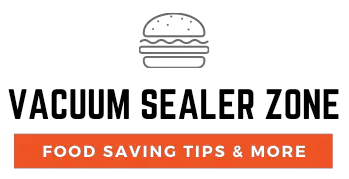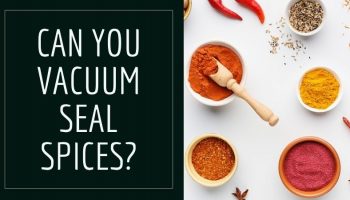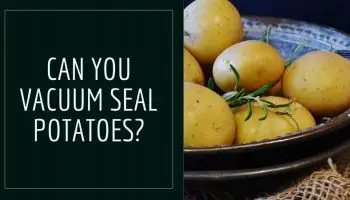In today’s modern society, food waste is a big problem. In the U.S. alone, almost forty percent of our food is thrown away annually.
Even if we try to do our part and save our leftovers to eat later, we don’t always manage to do so in the best way. Ziploc bags and Tupperware are great for a couple of days, but what if you want to keep food fresh for weeks at a time? That’s where a food vacuum sealer comes in handy.
I’m a health and eco-conscious person, so I always make sure to use and eat all the food that I buy. While my contribution is minimal in the grand scheme, I think we should all do our part to reduce waste in all its forms, especially when it comes to food.
I had known about vacuum sealing for a while, but I never really saw the need for it, until I started meal planning. Each week I plan out and prepare a week’s worth of meals, but traditional packaging wasn’t keeping the food fresh enough to last.
By Friday and Saturday, my meals were either about to go bad or had already turned. Thankfully, once I started vacuum sealing my foods with the FoodSaver V2244 Vacuum Sealing System, my meals stayed fresh all week without risk of spoilage.
In fact, this machine is so good at protecting my food that if I skip a meal one week, I still feel confident eating it the next without having to throw it out.
Today I’ll be talking to you about the benefits of vacuum sealing your food and how the FoodSaver V2244 System can help you do your part to reduce waste and keep your meals fresh.
What is Vacuum Sealing?
Chances are you’ve heard of vacuum sealing, but you may not know exactly what the process is. Simply put, vacuum sealing is when you suck all of the air out of a package through a vacuum system, keeping the contents locked into an airtight container.
Many food suppliers use this process to keep foods from spoiling in transit. Since oxygen is one of the biggest contributors to food turning rotten, keeping air away from your food is crucial to keeping it fresher longer.
In addition to food, you can vacuum seal a wide variety of products to either keep them dry or save on storage space. Pillows, linens, and comforters can all be reduced in size with vacuum sealing, making storage much simpler.
Benefits of Vacuum Sealing your Food
If you are wondering if buying a vacuum sealer is worth it, here are the biggest reasons you should start doing it.
Save Money: reducing waste isn’t just about your impact on the world, but it also means that you don’t have to keep buying food after tossing out old and moldy leftovers. Vacuum sealing means you can store your food longer and save money in the long run
Eco-Friendly: if you’re like me and want to make a positive change to your environmental impact, then vacuum sealing can be a great way to do that. As long as you get reusable bags, vacuum sealing can be beneficial to the environment by reducing food waste
Keep Items Dry: as I mentioned, you can vacuum seal other things besides food. If you want, you can store matches, papers, and other delicate objects in a vacuum sealed the bag so it will stay secure and dry for when you need it.
No Stale Foods: when most of us think of vacuum sealing our food, we imagine doing it to things like produce and meat. However, dry foods like pasta, rice, and nuts also benefit from vacuum sealing.
Even though these items don’t spoil like other foods, they can still become stale or chewy over time. Vacuum sealing means that they retain freshness instead
Considerations for Buying a Vacuum Sealer
While many vacuum sealers use the same process to keep your products protected, there are some important factors that you should consider when choosing a model for your needs. Here are the top considerations to look at for food vacuum sealers.
Cost
For many of us, the price can determine whether or not we buy something. High-end units can cost hundreds of dollars, but lesser models may cost a hundred bucks or less.
One important thing to remember, however, is the cost of the bags. Many vacuum sealers only come with a handful of bags,
So you’ll need to replace them over time. Depending on the frequency of use, you may have a relatively sizable monthly cost to keep using your sealer.
Handheld vs. Countertop
For quick and easy sealing, you may want something that you can hold in your hand and carry with you.
Portable sealers are great for camping or light sealing that doesn’t require a completely airtight package.
However, for best results on food, you want a countertop model that can remove more air and keep your products fresher. Also, consider that most portable vacuum sealers are cheaper than countertop models.
Size
Even though you use a vacuum sealer for storage purposes, it’s important to keep in mind the ease with which you can store the unit itself. Some countertop models can be quite large,
so if you don’t have enough counter space, you may need to put the unit away when not in use. Keep in mind the dimensions of your sealer to make sure that it’s feasible to set up and take down, so you aren’t struggling with it before you even use it.
Versatility
Most vacuum sealers are designed to work with bags, but some may also be able to seal other containers, such as jars and Tupperware.
Also, you may be able to get away with using standard Ziploc bags, although they will not protect your food nearly as well as a proper vacuum seal bag.
If you want to get the most out of your device, choose a model that can be adapted to work with multiple containers so you aren’t limited to what you can seal.
Common Tips for Food Sealing
If you’re new to vacuum sealing, here are some general guidelines you should follow to get the most out of your machine.
- Don’t seal hot ingredients. Wait for them to cool and then seal them
- Don’t overfill your bags. Leave a space at the top for best results
- Leave extra space for powdered or granulated foods. Small objects can get sucked into the machine, so make sure you have ample room for the food and the suction device
- For best results, freeze fruits and blanch vegetables before you seal them
- Ideally, freeze liquids before sealing, so they don’t get sucked into the machine
- If you use a bag for raw meat, only reuse it with the same type of meat and make sure to wash thoroughly each time
- Wait a couple of minutes between uses to allow the machine to cool down
Pros
- Comes with multiple accessories for your convenience
- Ideal for delicate foods
- Easy to clean: certain parts are dishwasher safe
- Usable on a variety of containers
- Easy to operate
- Durable construction
- Lightweight
- Easy to store and set up
Cons
- Only compatible with FoodSaver bags (or something equivalent)
- In rare cases, the sealing mechanism may not work properly
- Some components may break under stress
- Warranty doesn’t cover all parts or labor, so you may have to pay for repairs or replacement unit
- On some occasions, the unit may seal the bag without sucking air out
Highlighted Features
- Comes with a heat sealing roll
- Five vacuum bags included: three quart-size bags and two gallon-sized ones
- Accessory hose included so you can use the sealer on canisters as well
- Crush-free option will keep delicate foods from getting damaged in the process
- Drip tray is removable and dishwasher safe
- Weighs only one pound
- Relatively small size makes storage a snap
- One-touch operation
- Food stays fresh up to five times longer than traditional storage methods
FAQs
Can you use other bags with this sealer? Like Ziploc bags?
Unfortunately, you can only use FoodSaver vacuum bags with this unit. However, some third-party suppliers can give you a product equivalent that is much cheaper.
Does it have a built-in cutter?
No, it does not. You have to use scissors or a knife to cut the bag to your specifications.
Can you reuse the bags?
Yes, you can, as long as you wash them out. Typically a bag will last about four or five times, depending on what you store inside. As long as you don’t put sharp objects in the bag or store too much liquid, then they will last for a while.
Final Verdict
Since I got my FoodSaver V2244, I’ve been sealing like a madman. Before I would avoid buying bulk foods since I was afraid I wouldn’t be able to eat them right away, or I would have to eat the same thing every day.
Now, however, I can buy lots of bulk ingredients and just store them in the freezer or refrigerator for later. Once I find a great price on meat, I’ll buy it and save it for later, so I save money in the long run.
I used to toss food out on a weekly basis, but now I rarely throw anything away.One particular thing I love about this machine is the hose attachment.
I like to store my meals in Tupperware containers, so the fact that I can vacuum seal those instead of bags means that I’m using the sealer all the time. Overall, I’m very satisfied with the V2244.



![Can You Vacuum Seal Tomatoes? [The Proper Way!]](https://vacuumsealerzone.com/wp-content/uploads/2021/08/Can-You-Vacuum-Seal-Tomatoes-350x200.jpg)